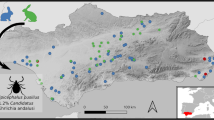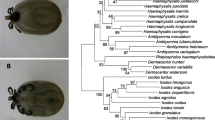Abstract
Based on seroprevalence studies and tick infection rates, tick-borne human granulocytic ehrlichiosis (HGE) is thought to occur in Germany, but to date no clinical case has been detected. Reported here are the first ehrlichial sequences derived from a German horse that fell ill with granulocytic ehrlichiosis. The analysis of three different genes (16S rRNA gene, groESL, and ankA) revealed up to 100% identity with ehrlichial sequences derived from patients with HGE in other countries or from infected ticks in Germany. Thus, the current lack of clinical cases of HGE in Germany is unlikely to result from the absence of pathogenic granulocytic ehrlichiae strains in German ticks.
Similar content being viewed by others
References
Bakken JS, Dumler JS (2000) Human granulocytic ehrlichiosis. Clin Infect Dis 31:554–560
Dumler JS, Barbet AF, Bekker CPJ, Dasch GA, Palmer GH, Ray SC, Rikihisa Y, Rurangirwa FR (2001) Reorganization of genera in the families Rickettsiaceae and Anaplasmataceae in the order Rickettsiales: unification of some species of Ehrlichia with Anaplasma, Cowdria with Ehrlichia and Ehrlichia with Neorickettsia, descriptions of six new species combinations and designation of Ehrlichia equi and 'HGE agent' as subjective synonyms of Ehrlichia phagocytophila. Int J Syst Evol Microbiol 51:2145–2165
Gribble DH (1969) Equine ehrlichiosis. J Am Vet Med Assoc 155:462–469
Madigan JE, Barlough JE, Dumler JS, Schankman NS, DeRock E (1996) Equine granuolocytic ehrlichiosis in Connecticut caused by an agent resembling the human granulocytotropic Ehrlichia. J Clin Microbiol 38:2917–2922
Bermann F, Davoust B, Fournier PE, Brisou-Lapointe AV, Brouqui P (2002) Ehrlichia equi (Anaplasma phagocytophila) infection in an adult horse in France. Vet Rec 150:787–788
Büscher G, Gandras R, Apel G, Friedhoff KT (1984) Der erste Fall von Ehrlichiosis beim Pferd in Deutschland. Dtsch Tierärtzl Wochenschr 91:408–409
Engvall EO, Pettersson B, Persson M, Artursson K, Johansson K-E (1996) A 16S rRNA-based PCR assay for detection and identification of granulocytic Ehrlichia species. J Clin Microbiol 34:2170–2174
Herrmann M, Baumann D, Lutz H, Wild P (1985) Erster diagnostizierter Fall von equiner Ehrlichiose in der Schweiz. Pferdeheilkunde 1:247–250
Johansson K-H, Pettersson B, Uhlen M, Gunnarsson A, Malmqvist M, Olsson E (1995) Identification of the causative agent of granulocytic ehrlichiosis in Swedish dogs and horses by direct solid phase sequencing of PCR products from the 16S rRNA gene. Res Vet Sci 58:109–112
Korbutiak E, Schneiders D (1994) Equine granulocytic ehrlichiosis in the UK. Vet Rec 15:387–388
McNamee PT, Cule AP, Donnelly J (1989) Suspected ehrlichiosis in a gelding in Wales. Vet Rec 124:634–635
Pusterla N, Huder JB, Feige K, Lutz H (1998) Identification of a granulocytic Ehrlichia strain isolated from a horse in Switzerland and comparison with other rickettsiae of the Ehrlichia phagocytophila genogroup. J Clin Microbiol 36:2035–2037
Shaw S, Kenny M, Taylor F, Day M, Birtles R, Pearse C (2001) Equine granulocytic ehrlichiosis in the UK. Vet Rec 149:127–128
Chen S-M, Dumler JS, Bakken JS, Walker DH (1994) Identification of a granulocytotropic Ehrlichia species as the etiologic agent of human disease. J Clin Microbiol 32:589–595
Petrovec M, Lotric-Furlan S, Avsic Zupanc T, Strle F, Brouqui P, Roux V, Dumler JS (1997) Human disease in Europe caused by a granulocytic Ehrlichia species. J Clin Microbiol 35:1556–1559
Fingerle V, Goodmann JL, Johnson RC, Kurtti TJ, Munderloh UG, Wilske B (1997) Human granulocytic ehrlichiosis in southern Germany: increased seroprevalence in high-risk groups. J Clin Microbiol 35:3244–3247
Hunfeld K-P, Brade V (1999) Prevalence of antibodies against the human granulocytic ehrlichiosis agent in Lyme borreliosis patients from Germany. Eur J Clin Microbiol Infect Dis 18:221–224
Baumgarten BU, Röllinghoff M, Bogdan C (1999) Prevalence of Borrelia burgdorferi and granulocytic and monocytic ehrlichiae in Ixodes ricinus ticks from southern Germany. J Clin Microbiol 37:3448–3451
Fingerle V, Munderloh UG, Liegl G, Wilske B (1999) Coexistence of ehrlichiae of the phagocytophila group with Borrelia burgdorferi in Ixodes ricinus from southern Germany. Med Microbiol Immunol 188:145–149
Madigan JE (1993) Equine ehrlichiosis. Vet Clin N Am Equine Pract 9:423–428
Caturegli P, Asanovich KM, Walls JJ, Bakken JS, Madigan JE, Popov VL, Dumler JS (2000) ankA: an Ehrlichia phagocytophila group gene encoding a cytoplasmic protein antigen with ankyrin repeats. Infect Immun 68:5277–5283
Chae J-S, Foley JE, Dumler JS, Madigan JE (2000) Comparison of the nucleotide sequences of 16S rRNA, 444 Ep-ank, and groESL heat shock operon genes in naturally occuring Ehrlichia equi and human granulocytic ehrlichiosis agent isolates from Northern California. J Clin Microbiol 38:1364–1369
Lotric-Furlan S, Petrovec M, Avsic Zupanc T, Nicholson WL, Sumner JW, Childs JE, Strle F (1998) Human granulocytic ehrlichiosis in Europe: clinical and laboratory findings in four patients from Slovenia. Clin Infect Dis 27:424–428
Massung RF, Owens JH, Ross D, Reed KD, Petrovec M, Bjöersdorff A, Coughlin RT, Beltz GA, Murphy CI (2000) Sequence analysis of the ank gene of granulocytic ehrlichiae. J Clin Microbiol 38:2917–2922
Sumner JW, Nicholson WL, Massung RF (1997) PCR amplification and comparison of nucleotide sequences from the groESL heat shock operon of Ehrlichia species. J Clin Microbiol 35:2087–2092
Petrovec M, Sumner JW, Nicholson WL, Childs JE, Strle F, Barlic J, Lotric-Furlan S, Avsic Zupanc T (1999) Identitiy of ehrlichial DNA sequences derived from Ixodes ricinus ticks with those obtained from patients with human granulocytic ehrlichiosis in Slovenia. J Clin Microbiol 37:209–210
Pearson WR, Wood T, Zhang Z, Miller W (1997) Comparison of DNA sequences with protein sequences. Genomics 46:24–36
Acknowledgements
This work was supported by grants from the German Ministry for Education and Research, the Interdisciplinary Center for Clinical Research of the Friedrich-Alexander University Erlangen (Project A14) and from the German Research Foundation (SFB263 project A5).
Author information
Authors and Affiliations
Corresponding author
Rights and permissions
About this article
Cite this article
von Loewenich, F.D., Stumpf, G., Baumgarten, B.U. et al. A Case of Equine Granulocytic Ehrlichiosis Provides Molecular Evidence for the Presence of Pathogenic Anaplasma phagocytophilum (HGE Agent) in Germany. Eur J Clin Microbiol Infect Dis 22, 303–305 (2003). https://doi.org/10.1007/s10096-003-0935-1
Published:
Issue Date:
DOI: https://doi.org/10.1007/s10096-003-0935-1




